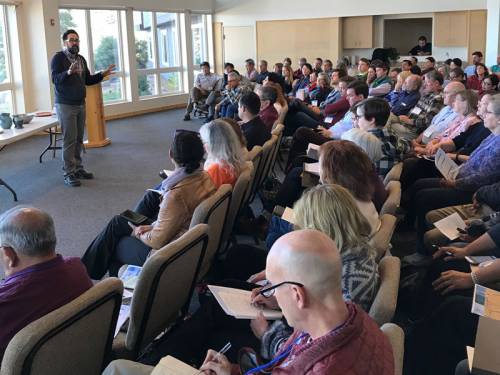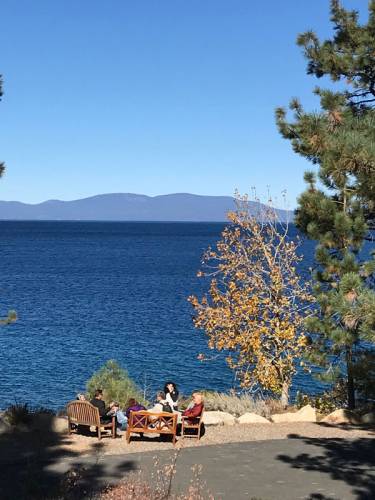Conference attendees practice dwelling in the presence of God — and each other
By Paul Seebeck | Presbyterian News Service

Jason Santos addressing the question of “What is Sabbath?” with 135 attendees at the evangelism conference at Zephyr Point. Brian Frick
ZEPHYR COVE, Nev. – During Tuesday morning plenary at the national evangelism conference “Sabbath Rest, Holy Surrender, Full Life,” 135 attendees were encouraged by Ryan McKenzie, director of program ministries at Zephyr Point Presbyterian Conference Center, to “silence themselves.”
“Allow God to speak to through creation,” he said, “until a sense of shalom returns.”
As McKenzie spoke of how the leaves at Zephyr Point are “exploding in color” and how one can watch glimpses of sparkling light that is formed when sunlight reflects off the water, the Rev. Dr. Jason Brian Santos reminded those gathered for his morning plenary on “What is Sabbath?” to take advantage of their free time in the afternoon.
“Don’t let your distractions fill the space,” he said. “Allow your spirits to dwell and unpack what are actually reflections of Sabbath.”
And that’s what Santos, the Presbyterian Mission Agency’s director of Christian formation, believes the Sabbath is about — dwelling in the presence of the God of creation who formed us.
Santos has spent much of his life studying theology and ministry. At Princeton Seminary, his dissertation was on the doctrine of Sabbath — and on the ecumenical, monastic community of Taizé, in France, which he first visited in 2005.
“It blew me away that 100,000 young people came there during the summer,” he said. “And within a week, they referred to it as their spiritual home.”
Santos wanted to know why. With research money, he was able to return to Taizé. In interviews with more than 500 pilgrims, the word “remember” kept coming up in conversations.
“They came back because they wanted to remember what’d they’d experienced through Taizé practices of daily prayer, Scripture reading, sharing groups, silence and communal work,” he said.

Surrounded by the beauty of Lake Tahoe at Zephyr Point Presbyterian Conference Center, evangelism conference participants discuss the meaning of Sabbath in small groups. Brian Frick
But Santos wondered what it was that young adults wanted to remember. Was it the unique daily rhythm? The Eucharist? As he pondered these questions, Santos read The Sabbath, a Jewish spiritual classic by Abraham Joshua Heschel.
“Through this transformative book I realized, ‘This is what I’ve been missing,’” said Santos. “These young people go to Taizé and return, because it’s where they experience Sabbath.”
In his research, “paradise,” “kingdom of God” and “Christian community” were words Santos kept coming across to describe Sabbath. But how did they relate to Heschel’s understanding of Sabbath that was rooted in the story of creation, when God created for six days and rested on the seventh day?
“Heschel saw that the very last thing God created was humanity,” Santos said. “And the very first thing God did with humanity was to dwell with them. He saw beauty and sacredness in this. In Sabbath, we are to rest with God, before going back into humanity, as a refreshed people.”
But in the unfolding Scripture narrative of humanity’s fall from paradise to the Israelites in slavery for 400 years, what the Israelites knew was the ground was cursed — and constant work.
During their exodus to freedom, when they cried out to God about not having enough food to eat in the wilderness — suggesting that they were better off as captives in Egypt — God sent them manna to eat. They were to collect this “bread of heaven daily,” except on the sixth day when they took in twice the amount, so they could rest on the seventh day.
“The pattern is created again; the curse has been put aside,” said Santos. “They were to return to the way things were by stepping away from an earthly rhythm into a holy rhythm.”
For Heschel, God was actually making time holy — in contrast to humans trying to make the material world holy. Building cathedrals and making certain parts of the world more holy than others, even though it will eventually pass away, is about our desire “to control the holy.”
Yet in the Exodus narrative, Santos pointed out that God is in the burning bush, the fire and clouds — and doesn’t even occupy space until David builds the Temple. And when the Israelites are slowly making their way back to the Temple, God promises to dwell in their hearts.
“It comes back to, we have to return to God to dwell with God,” Santos said, “to a God that is not defined by the material world and to a God who sanctified time in the pattern of holy rest.”
Santos has come to believe that this is what the fellow pilgrims at Taizé wanted to remember. By leaving behind their earthly rhythms for a week and entering into a holy rhythm, they experienced Sabbath as a paradise lost and a paradise yet to come.
“Does it feel like this in our Sabbath spaces?” Santos asked. “Or does it feel rote, like an obligation? What is it that we can do in our Sabbath spaces, where when people leave, they will say, ‘I feel like I experienced Sabbath’?”
After the plenary, conference-goers talked about these questions — and about what they’d heard.
Amy House, a pastor from Columbus, Ohio, was excited. “It’s making me mentally reshape what Sabbath could mean and what we can change,” she said.
Campus minister Evans McGowan of Ann Arbor, Michigan, said he felt like he wanted to be a person who could help others experience Sabbath.
“This sacredness of time really got to me,” he said. “When I was in Kenya, people there told me, ‘You Americans take time. Here, we hold on to time.’ What if one of the gifts of Sabbath is God holding on to time for us? How might we receive that?”
—
The national evangelism conference, planned by PMA’s Theology, Formation & Evangelism ministries, continues through Thursday, Oct. 18, concluding with evening prayers and a time of rest and breakfast the following morning.
![]() You may freely reuse and distribute this article in its entirety for non-commercial purposes in any medium. Please include author attribution, photography credits, and a link to the original article. This work is licensed under a Creative Commons Attribution-NonCommercial-NoDeratives 4.0 International License.
You may freely reuse and distribute this article in its entirety for non-commercial purposes in any medium. Please include author attribution, photography credits, and a link to the original article. This work is licensed under a Creative Commons Attribution-NonCommercial-NoDeratives 4.0 International License.
Categories: Evangelism & Discipleship
Tags: evangelism, evangelism conference, holiness, rest, sabbath, sabbath rest, sanctuary, taize, zephyr point
Ministries: Evangelism, Theology, Formation & Evangelism